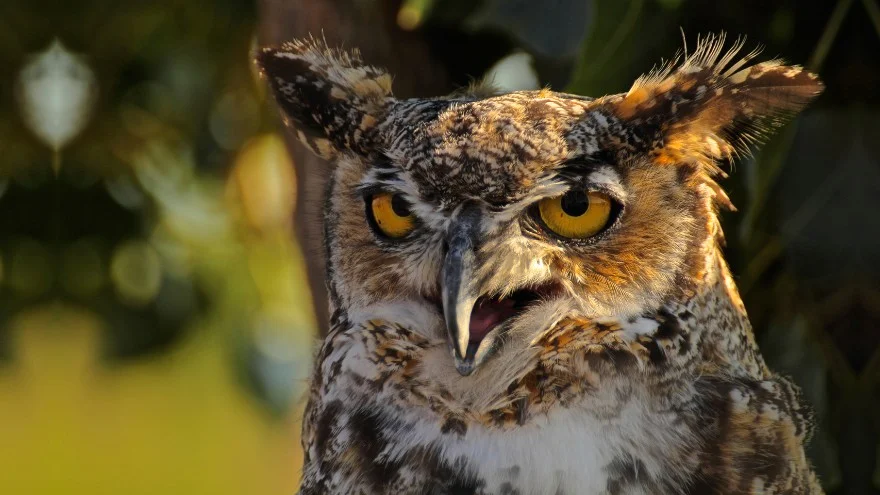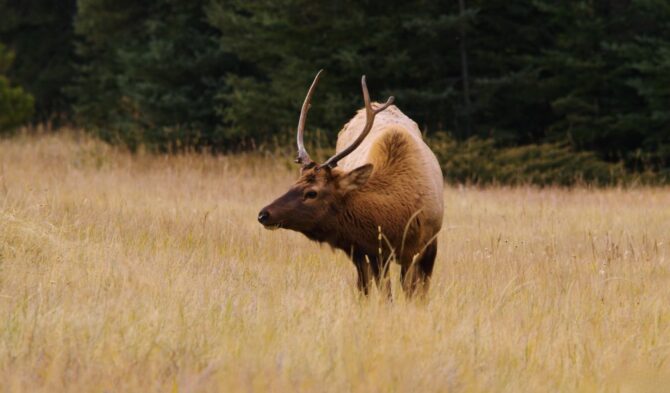In the Pacific Northwest region of the Western United States sits the state of Oregon. It is a fascinating place known for its incredible natural beauty, like Crater Lake, Mount Hood, and Cannon Beach.
In addition to being renowned as the “Beaver State,” Oregon is home to at least 500 different bird species, 15 of which are owls that can be seen at different times of the year.
Many people still wonder if there are owls that live in the great state because they are a rare sight due to their nocturnal and camouflage habits. But they do, of course!
Some of the species of owls in Oregon include the barn owl, boreal owl, barred owl, snowy owl, spotted owl, and more. You can spot several distinct kinds if you listen to their calls and look for them in the trees.
Keep reading to learn about the 15 species found in the state of Oregon, their taxonomy, physical features, habitat, calls, behaviors, and more.
The 15 Species of Owls in Oregon
Many people love owls because they are enigmatic and smart birds. They don’t build nests as other birds do; instead, they use tree cavities, nests established by other species, naturally occurring structures, or human platforms.
They can be found in Oregon’s astounding range of environments, from mountains and forests of conifers to deserts and forests of deciduous trees.
Most of the owls in Oregon are nocturnal hunters who stalk the night for insects, fish, frogs, birds, mice, and other small mammals. You can hear their hoots, screeches, and calls in the early morning or after dark.
1. Barn Owl
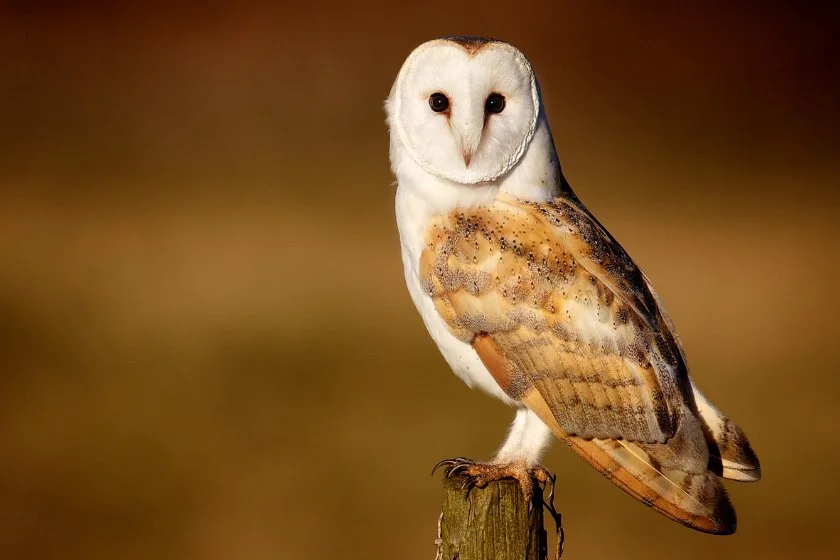
- Scientific name: Tyto alba
- Length: 12.6 – 15.8 inches (32 – 40 cm)
- Weight: 400 – 700 g (0.9 – 1.5 lbs)
- Wingspan: 99.1 – 114.3 cm ( 39 – 45 inches)
The barn owl is a pale-colored, medium-sized owl with long wings and a short, squarish tail. Its most distinguishing feature is its white heart-shaped face.
It resides in Oregon permanently and can be found all across the state. This owl lives up to its name by regularly inhabiting barns and other abandoned buildings. They can also be found in dense clusters of trees and hollow tree trunks.
The loud, harsh call of the barn owl as it soars over a field or marsh in search of small rodents is one of the most striking sounds in the pitch-black of night.
This owl has excellent hearing and night vision, and with these features, it can hunt prey in total darkness.
Rodents make up the bulk of a barn owl’s diet. It consumes a lot of voles, as well as different kinds of mice, small rats, shrews, young rabbits, and other mammals. It also consumes insects, lizards, birds, frogs, and fish in very limited quantities.
Barn owls have a mutualistic relationship with people, mainly farmers. Of all the owl species, they are the least threatening despite being the most common.1
They are not extremely territorial or protective of their young and are rather timid owls.
2. Barred Owl
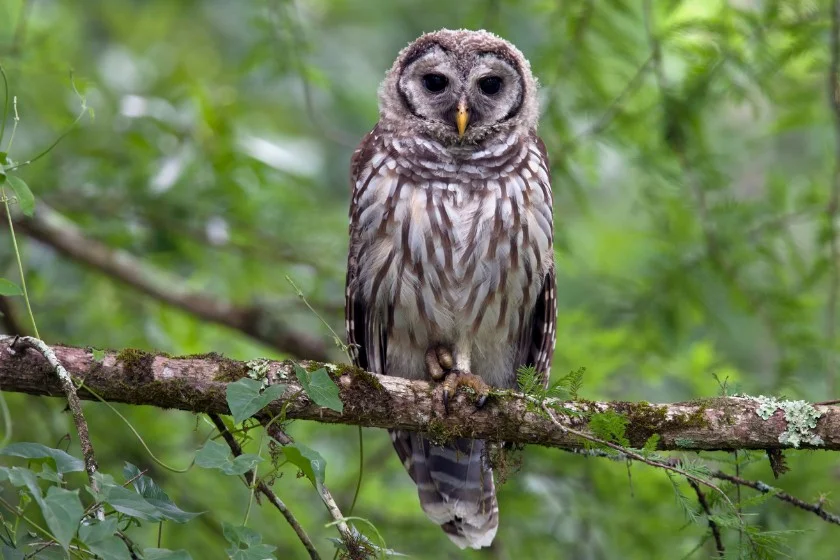
- Scientific name: Strix varia
- Length: 16.9 – 20.1 inches (43 – 51 cm)
- Weight: 470 – 1050 g (1.0 – 2.3 lbs)
- Wingspan: 96 – 125 cm (37.8 – 49.2 inches)
The barred owl is a large monogamous owl species native to North America. It is also known as the northern barred owl, the striped owl, or, more colloquially, the hoot owl.
Although they are primarily native to eastern North America, they have spread to the continent’s west coast and are now regarded as invasive.
They can adapt to different gradients of open woodlands, but mature forests are their preferred habitat.
The name “barred owl” refers to the bird’s head, chest, and back feather patterns, which are barred with alternate rows of white and brown.
Barred owls are nocturnal birds best known for their distinctive vocalizations, which travel more than 0.8 kilometers.
They are the most likely owls to be seen during the day because, despite being primarily nocturnal, they frequently hunt on cloudy days and can be seen at dawn and dusk.
Voles, mice, and shrews are the main prey items for barred owls. Small birds, squirrels, rabbits, bats, snakes, and even fish for crayfish and frogs are among the other animals eaten by these owls.
The Barred owl typically avoids interacting with people unless it is unable to. They become hostile when they perceive a threat or when someone comes too close to their nest or babies.
3. Boreal Owl
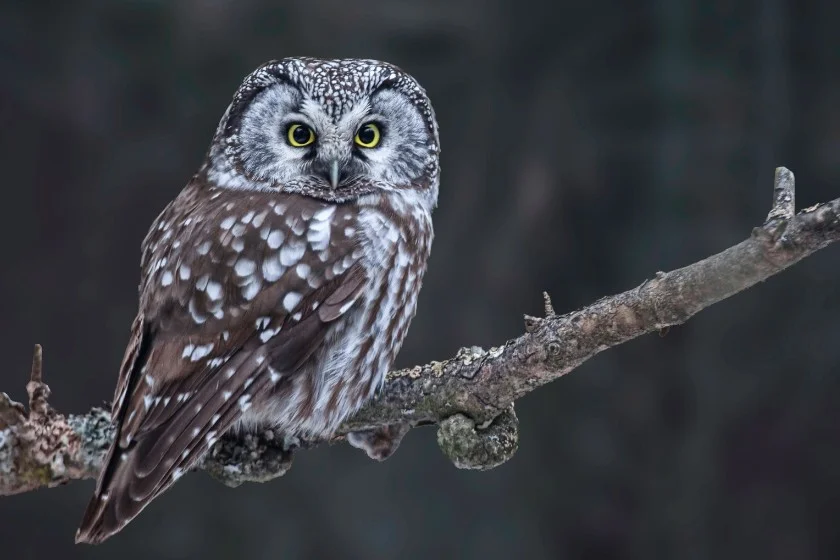
- Scientific name: Aegolius funereus
- Length: 8.3 – 11.0 inches (21 – 28 cm)
- Weight: 93 – 215 g (0.2 – 0.5 lbs)
- Wingspan: 21.6-24.4 inches (55 – 62 cm)
The Boreal owl is a diminutive predator inhabiting the dense forests of northern North America and Eurasia. The boreal forest, found in the north, inspired its name.
It has a white facial disk with nearly black upper corners, a light-colored bill, and raised white eyebrows that give it a startled expression.
This owl distinguishes itself from all other owls by having three rows of white spots on the dorsal surface visible when the tail is folded tightly.
Boreal owls are year-round residents of Oregon, but they are most frequently found in the state’s northeastern corner and dense mixed-wood and temperate coniferous forests.
Occasionally, people can locate these owls when they are calling during the breeding season. Their call is rapid and soft, and can be heard up to 1.5 miles away. This call is frequently misidentified in the spring as the snipe winnowing call.
In addition to birds, insects, and other invertebrates, boreal owls primarily hunt voles and other mammals.
Due to their asymmetrical external ear structure, boreal owls can locate their prey by hearing the sound that the prey makes.
They also pay close attention to movement and can find prey even through vegetation and under snow.
Due to its shyness and evasive response to human activities, nocturnal habits, and preferred inaccessible taiga forest habitat, the boreal owl is rarely seen by humans.
These owls will shrink away into a concealment position when they detect a predator nearby, staying still and getting as small as they can to avoid being seen.
4. Burrowing Owl
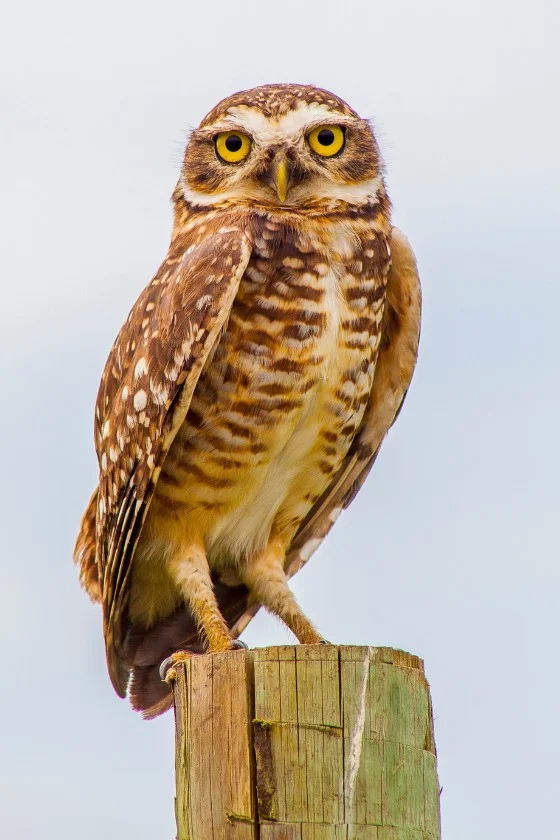
- Scientific name: Athene cunicularia
- Length: 7 – 10 inches (17.8 – 25.4 cm)
- Weight: 140 – 240 g (0.3 – 0.5 lbs)
- Wingspan: 20 – 24 inches (50.8 – 61 cm)
The burrowing owl, also known as the shoco, billy owl, prairie dog owl, ground owl, or howdy owl, is a small, long-legged ground-dwelling owl with sandy coloring and bright yellow eyes. It is a small owl species known to rest on the ground.
As its name suggests, the burrowing owl lives in abandoned dens of prairie dog and ground squirrel burrows, though it will occasionally dig its own burrow if none are available.
Except for higher mountains, it is a spring and summer visitor to open grassland and shrub-steppe habitats in eastern Oregon.
The burrowing owl is not a particularly vocal species, yet it is capable of making a range of cooing, warbling, rasping, clucking, shrieking, and rattling sounds.
Males most frequently make a two-note cooing sound similar to a quail during mating and territorial defense.
Burrowing owls largely feed on small birds, reptiles, fish, rodents, and large insects. They have impeccable night vision and hearing and can take advantage of this when they hunt at night, although they are majorly diurnal birds.
These owls frequently exhibit a wry sense of humor –these owls can put on quite a show day or night, trotting after and pouncing on bugs in the prairie.
Instead of flying away when startled, burrowing owls frequently run or flatten themselves against the ground. They also have other self-defense methods to protect themselves from predators.
5. Flammulated Owl
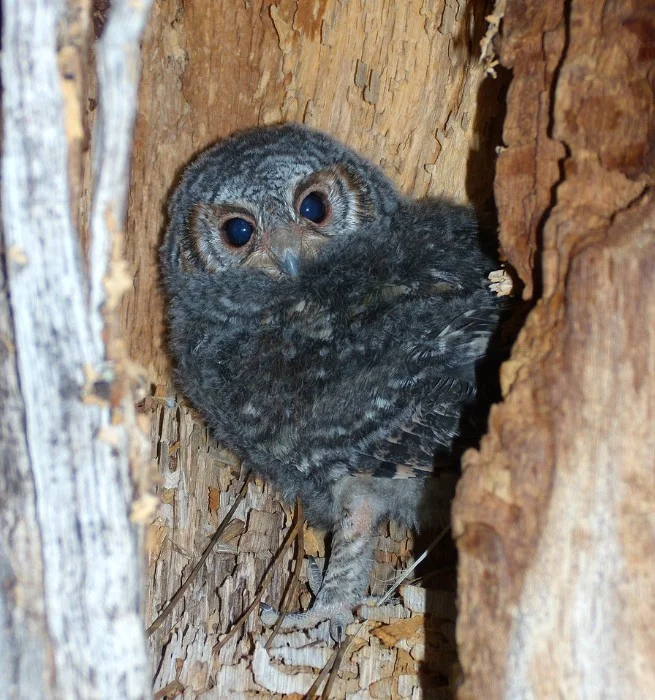
- Scientific name: Psiloscops flammeolus
- Length: 5.9 – 6.7 inches (15 – 17 cm)
- Weight: 43 – 63 g (0.09 – 0.14 lbs)
- Wingspan: 15.9 – 16.1 inches (40.5 – 41 cm)
The flammulated owl is a small migratory North American owl belonging to the Strigidae family. It is also known as the dwarf owl or the flammulated scops owl.2
It is the sole species included in the Psiloscops genus. It got its “flammulated” name from the flame-like markings on its face.
These owl species are distinctive because they possess many traits that do not correspond to the standard owl description.
One is that when they are hunting, they rely more on their vision than their hearing. Additionally, their primary flight feathers are less adapted compared to other species.
The specialized protrusions on these feathers that silence flight motions are absent in flammulated owls. They fly much noisier than other owls as a result.
Unlike other small owls, flammulated owls will produce a hoarse call due to their distinctive vocal anatomy – this call contains low-frequency notes that resemble the calls of large owls.
Mountains with old established coniferous and mixed coniferous-deciduous forests are where you can find the flammulated owl species.
They breed on the eastern side of the Cascades, in the Blue and Wallowa mountains, and sparsely in the southwest Oregon mountain ranges.
6. Great Gray Owl
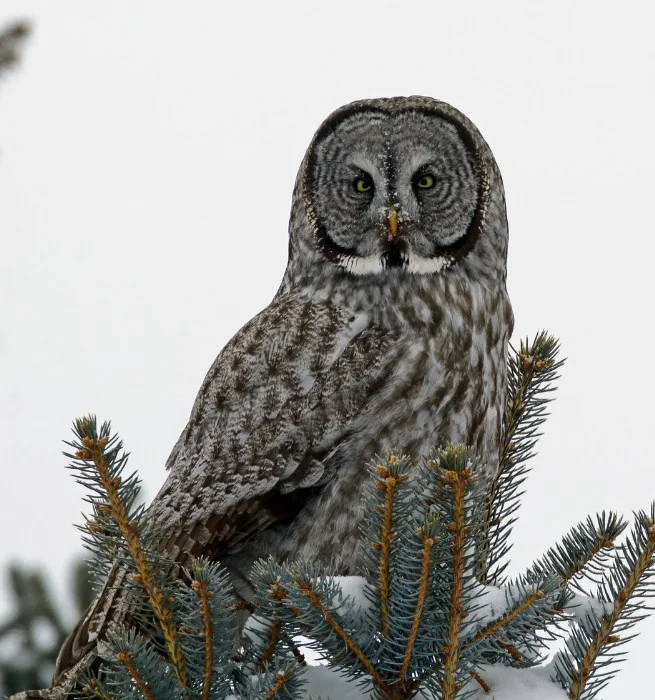
- Scientific name: Strix nebulosa
- Length: 24.0 – 33.1 inches (61 – 84 cm)
- Weight: 700 – 1700 g (1.5 – 3.8 lbs)
- Wingspan: 53.9 – 60.2 inches (137 – 153 cm)
Great grays are among the tallest owls, with long tails and broad wings. They are much larger than most other owls, with most of their mass made up of feathers.
They have large facial disks and big heads for owls. Although not the most massive owl, the great gray is the biggest in North America.
Its other names include the Great Gray Ghost, the Phantom of the North, the Lapland Owl, the Striped Owl, the Sooty Owl, and the Spectral Owl.
The sounds of great gray owls are distinctive from those of other owls. Although they also hoot, they use other sounds like clicks and screeches.
These owls stand out from other species due to their large size, yellow eyes, bow tie under the face, lack of breast barring, and more distinct concentric rings on the face.
Dense evergreen pine and fir forests with nearby meadows or small openings are some of the habitats where great grays can be found.
They also inhabit subarctic swampy evergreen forests with bogs and other openings. These owls typically avoid areas with people and avoid drawing attention to themselves.
The hours before dawn and dusk are prime times for great gray owl hunting. They silently soar low over meadows on broad wings, scanning the ground for small mammals.
They consume voles, mice, squirrels, young rabbits, hares, rats, moles, and weasels, among other small mammals. Additionally, great grays eat smaller birds like thrush, grouse, quails, ducks, and small hawks.
7. Great Horned Owl
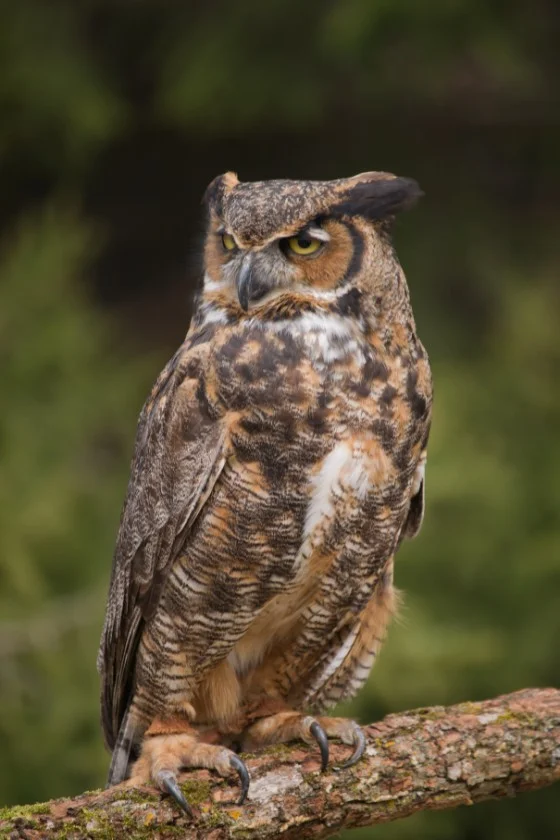
- Scientific name: Bubo virginianus
- Length: 18.1 – 24.8 inches (46 – 63 cm)
- Weight: 910 – 2500 g (2.0 – 5.5 lbs)
- Wingspan: 39.8 – 57.1 inches (101 – 145 cm).
The great horned owl is a large, thick-bodied owl indigenous to the Americas. It is the most widely distributed true owl in the Americas and an incredibly adaptable bird with a wide range.
It has broad, rounded wings and two pronounced feathered tufts on its head. It is also known as the tiger owl or the hoot owl.
Great horned owls live in backyards, cities, forests, and even deserts. They are nocturnal birds and can be found perched on fence posts or tree limbs at the edges of open spaces at dusk.
You might also see them flying across roads or fields with stiff, deep beats of their rounded wings. They make a deep, staccato series of four to five hoots as their call.
The main prey items in a great horned owl’s diet are rabbits, hares, rats, mice, and voles, but it also freely hunts other small mammals, larger mid-sized mammals, birds, reptiles, amphibians, and invertebrates.
Known for being fearless and aggressive, the great horned owl frequently attacks prey that is heavier and larger than it, such as cats, skunks, and porcupines.
These birds will also attack large dogs and other predators, including humans if their nesting area is in danger.
8. Long-eared Owl

- Scientific name: Asio otus
- Length: 13.8 – 15.8 inches (35 – 40 cm)
- Weight: 220 – 435 g (0.5 – 0.96 lbs)
- Wingspan: 35.4 – 39.4 inches (90 – 100 cm)
The long-eared owl, also known as the northern long-eared owl, the lesser horned owl, or; the cat owl, is a medium-sized brown feathered owl species with an extensive breeding range.
The species breeds in many areas throughout Europe and the Palearctic, as well as in North America. This owl is usually found in woodlands, fields, and wetlands.
The most distinctive features of a long-eared owl are its tall head feather’ ear tufts’, which are more distinguished than those of the short-eared owl.
It will raise these when alarmed, presenting a striking figure when combined with its deep orange eyes.
If the tufts are flat, they can be confused with the short-eared owl. However, the short-eared owl has yellow eyes and is generally paler.
Long-eared owls are more or less strictly nocturnal in activity. Usually, activity for the species commences at dusk.
They are secretive and superbly camouflaged. One good way to find them is to listen at night in spring and summer for their long, low hoots.
The long-eared owls eat mostly small mammals, including voles, many kinds of mice, kangaroo rats, shrews, pocket gophers, and young rats or rabbits.
9. Northern Hawk Owl
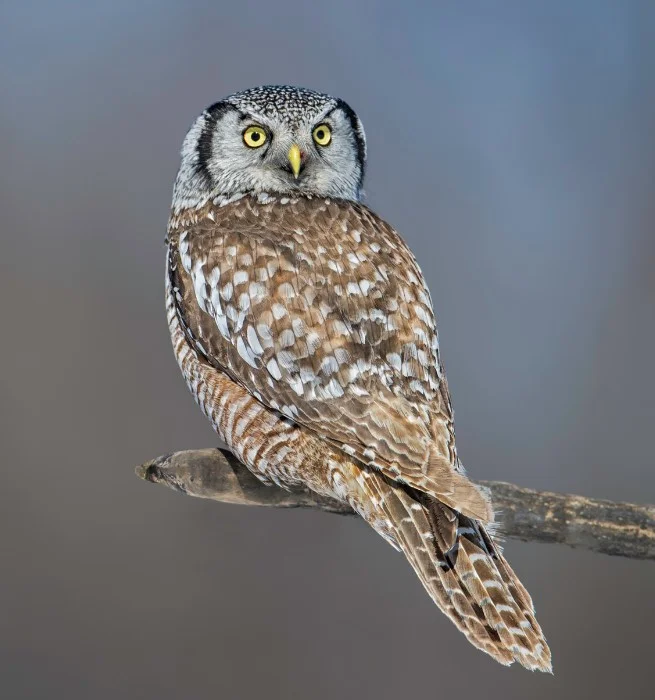
- Scientific name: Surnia ulula
- Length: 35 – 43 cm (13.8 – 16.9 inches)
- Weight: 215 – 375 g (0.47 – 0.83 lbs)
- Wingspan: 69 – 82 cm (27.2 – 32.3 inches)
The boreal forests are home to the northern hawk owl, which looks like an owl but acts like a hawk. It is an owl due to its round face, oval body, and yellow eyes enclosed in dark parentheses.
But despite having a longer tail than a hawk, it prefers solitary trees for perching and prefers to hunt during the day.
The northern hawk owl is the only species still existing in the genus Surnia of the family Strigidae. It is a true medium-sized owl of the northern latitudes.
Although it occasionally irrupts southward, this non-migratory species typically stays in its breeding range. It is one of the few owls that are only active during the day and is neither nocturnal nor crepuscular.
Unlike most other owl species, the northern hawk owl does not fly on silent wings. Because its feathers are more rigid than nocturnal owls, it makes some noise when it flies. Normally, it can’t catch prey using just its hearing.
The northern hawk owl has a long, loud, and rapid call.
In Oregon, seeing a northern hawk owl is uncommon. Most of the year, they are solitary, but they appear reasonably tolerant of other birds, including other owls, in their territory.
However, they are aggressive toward intruders, including humans, who approach the nest site.
These owls feed mostly on voles and mice during the summer, along with a few small squirrels, weasels, and shrews. In winter, they will consume small birds.
10. Northern Pygmy Owl
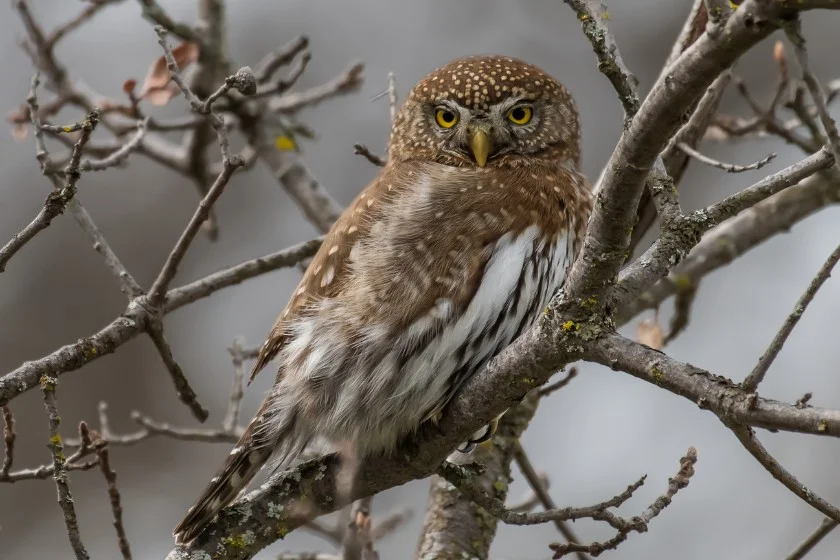
- Scientific name: Glaucidium californicum
- Length: 7 – 7.5 inches (17.8 – 19.1 cm)
- Weight: Male: 62.4g (0.14 lbs); Female: 73.7g (0.16 lbs)
- Wingspan: 14.5 – 16 inches (36.8 – 40.6 cm)
The northern pygmy-owl is a small, vicious hunter without ear tufts that enjoys eating songbirds. The Californian pygmy-owl, Coast pygmy-owl, Rocky mountain pygmy-owl, and Vancouver pygmy-owl are other names for this bird.
These owls have long tails, round heads, and piercing yellow eyes and are primarily dark brown and white. These little owls are indigenous to western North America.
They are known to nest and forage in the middle of thick, continuous forests close to streams in Oregon and Washington.
On the back of its head, the northern pygmy owl has two black nape spots with white borders that resemble eyes (they are actually eyespots that can deter rear attacks by mobbers).3
It differs quite a bit from most owls in that it does not have the asymmetrical ear openings other owls have for nighttime hunting.
It also lacks the facial disk that other species have. Since daylight hunting requires more visual than auditory skills, they don’t need all of these adaptations.
The northern pygmy-owl is unusual among typical owls because it does not fly quietly. Its wings produce a buzzing or whirring sound when it flies.
Its size and color make it incredibly difficult to spot. These pygmy-owls are skilled hunters with a wide range of potential prey –small mammals, small to medium-sized birds, reptiles, larger insects, and amphibians present in their habitat may fall under this category.
11. Northern Saw-Whet Owl
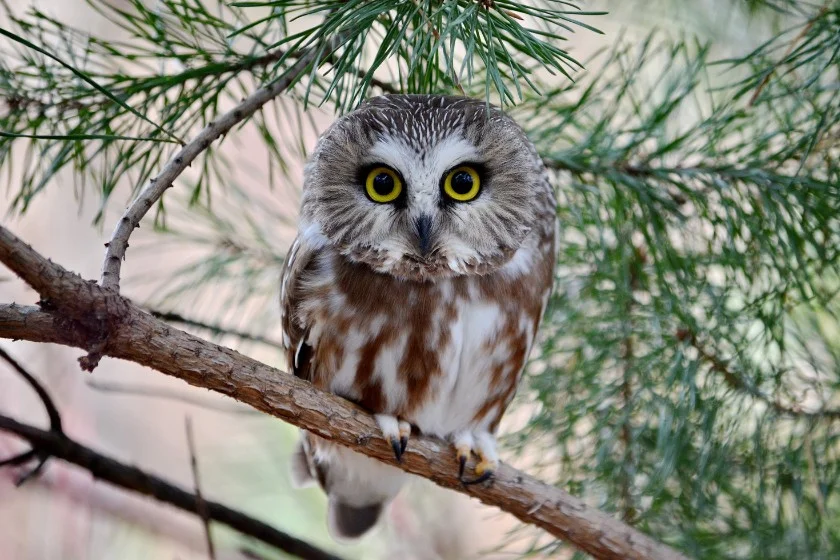
- Scientific name: Aegolius acadicus
- Length: 7.1 – 8.3 inches (18 – 21 cm)
- Weight: 65 – 151 g (0.14 – 0.33 lbs)
- Wingspan: 16.5 – 18.9 inches (42 – 48 cm)
Northern saw-whet owls are brown with white spots on their heads, whitish facial disks, and bright yellow eyes. They are small owls of the Strigidae family indigenous to North America.
These owls are also known as Acadian owls, Blind owls, Kirkland’s owls, Saw-filers, Sparrow owls, White-fronted owls, Farmland owls, Little Nightbirds, and the Queen Charlotte owls.
The northern saw-whet spend most of their year in wooded areas and mature forests throughout much of Oregon.
These owls are difficult to see because they are strictly nocturnal and solitary, but they have a shrill, penetrating call that they repeatedly emit.
Like many owls, they have exceptional hearing and night vision. Northern saw-whet owls can locate their prey precisely because the sound reaches the ears at different times and is of different intensities.
They can hunt by hearing alone in total darkness thanks to their ability to localize sounds with such accuracy.
Northern saw-whet owls frequently bring one wing around to the front of their body and lengthen their bodies to resemble tree branches when they perceive danger.
They primarily consume small mammals but also small passerine birds like swallows, sparrows, kinglets, and chickadees to supplement their diet. These owls can also feed on crustaceans, frogs, and aquatic insects along the Pacific coast.
12. Short-Eared Owl
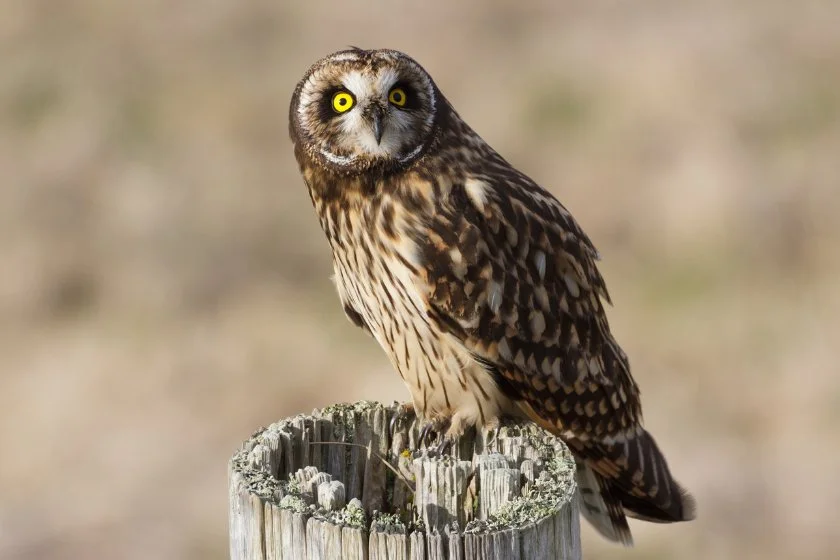
- Scientific name: Asio flammeus
- Length:13.4 – 16.9 inches (34 – 43 cm)
- Weight: 206 – 475 g (0.45 – 1.05 lbs)
- Wingspan: 33.5 – 40.5 inches (85 – 103 cm)
The medium-sized short-eared owl, also called the grass owl, has a large round head, tiny ear tufts, yellow eyes, a black beak, and long, broad wings with black patches on the “wrists.”
A pale buff facial disk and a sizable tawny patch at the base of the primaries, which causes a noticeable flash in flight above, are its distinguishing features.
Although field observers hardly notice these tufts, it was given this name for the unnoticeable “ear” tufts that rise from the middle of its forehead.
Due to its preference for open terrain and its crepuscular habits, the short-eared owl is one of the most noticeable.
It is frequently seen hunting low over the ground across marshes, fields, and other open areas while flying slowly and erratically.
The fact that this owl rarely vocalizes and is typically seen rather than heard sets it apart from most other owls – they are usually silent except during the winter, during the breeding season, or when warning intruders.
The short-eared owl eats small mammals like voles, moles, mice, and rabbits, as well as bats, weasels, shrews, and occasionally birds.
13. Snowy Owl
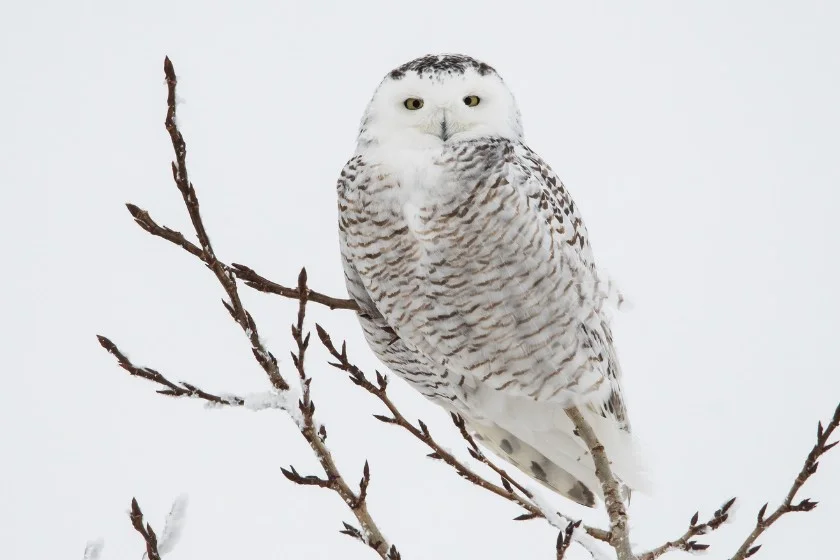
- Scientific name: Bubo scandiacus
- Length: 20.5 – 27.9 inches (52 – 71 cm)
- Weight: 1600 – 2950 g (3.5 – 6.5 lbs)
- Wingspan: 49.6 – 57.1 in (126 – 145 cm)
The true owl family’s large, white snowy owls have varying amounts of black or brown markings on their bodies and wings.
They are also called Arctic owls, White owls, and Polar owls. Native to the Arctic regions of North America and the Palearctic, snowy owls primarily breed on tundras.
The snowy owl is one of the world’s most recognizable owl species. These birds are the only species with a distinctive white coloration that is sparsely stippled with a dark brown hue.
The birds’ brilliant yellow eyes stand out more thanks to this coloring. This owl species is known to make low, powerful, raspy hoots as part of their territorial call.
Northeast Oregon, the central to southern Cascades, and the Siskiyou Mountains are where you can find snowy owls.
The snowy owl is active during the day, especially in the summer, unlike most owls that sleep during the day and hunt at night.
While on nesting grounds, snowy owls have been known to attack humans. Typically, the males are the ones who attack and defend the nest and their territory.
However, it has been documented that female snowy owls have attacked people when their young are nearby.
14. Spotted Owl

- Scientific name: Strix occidentalis
- Length: 18.5 – 18.9 inches (47 – 48 cm)
- Weight: 500 – 700 g (1.1 – 1.5 lbs)
- Wingspan: 39.8 inches (101 cm)
The Spotted Owl, also referred to as the Western Barred Owl, Canyon Owl, Brown-eyed Owl, Wood Owl, and Hoot Owl, is a medium-sized owl comparable in size to an American Crow.
It’s become well known for being among North America’s most well-studied and well-publicized endangered species.
It frequently resides in Oregon’s Douglas-fir, grand fir, ponderosa pine, and incense cedar trees.
From the coastal mountains to the eastern foothills of the Cascade Range, it is a year-round resident of the forested areas of western Oregon.
Spotted owls typically live in one territory for most of their lives, and they are more vulnerable because of their sedentary lifestyle, strict habitat requirements, trusting nature, and loud vocalizations.
They are in danger of going extinct because of clear-cut logging, which has led to the loss of their vital habitat and their reliance on sizable areas of old-growth coniferous forests.
The spotted owl is a nocturnal, passive predator. It frequently swoops or pounces on its prey while hunting from a perch or takes arboreal prey from tree limbs and boles.
Hoots, whistles, barks, chatters, grunts, and groans are some of the sounds the spotted owls uses to communicate.
Small to medium-sized mammals, including rodents (mice, rats, voles, gophers, squirrels), bats, birds, reptiles, and arthropods, are spotted owls’ main prey items.
Additionally, they have been observed prowling around campgrounds in search of food scraps.
15. Western Screech Owl
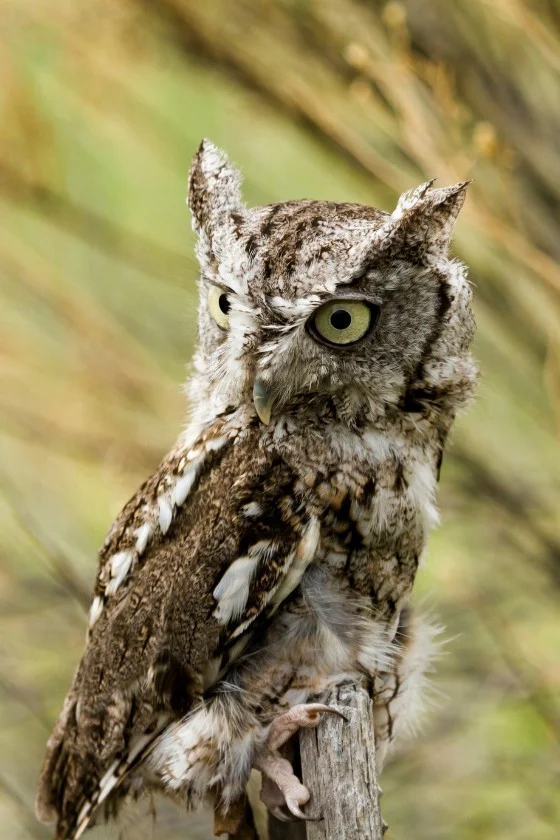
- Scientific name: Megascops kennicottii
- Length: 7.5 – 9.8 inches (19 – 25 cm)
- Weight: 100 – 305 g (0.22 – 0.67 lbs)
- Wingspan: 21.6 – 24.4 in (55 – 62 cm)
The western screech-owl is a tiny owl that comes in a variety of colors. They have rounded heads and bodies, small, pointed ear tufts, big yellow eyes, a yellow bill, and large yellow eyes.
The western screech-owl does not make a screeching sound but rather a series of trills that resemble the sound of a ball being bounced.
These owls can hunt using their keen hearing and vision to locate prey at dawn, at night, or just before dusk.
The western screech owl is a fairly frequent year-round resident throughout Oregon. It is typically found below 3,000 feet in western Oregon, though it has been recorded at least as high as 4,100 feet in the western Cascades.
In woodlands with lower elevations, the species is more commonly found in spring and early fall.
Western screech-owls hunt using their keen hearing and vision to locate prey. They hunt by waiting on perches, swooping down on unaware prey, and catching insects as they fly.
These owls eat various things, including small mammals, birds, insects, some reptiles, and amphibians.
To frighten off predators, the owl would stand upright, hold up its ear tufts, slick down its feathers, and draw its feathers around its forward-facing beak.
Additionally, they would squint, mimicking a branch’s movement with their eyes swaying back and forth.
Best Bird-Watching Spots in Oregon
Here are the top 15 bird-watching locations in Oregon that anyone can enjoy visiting:
- Steens Mountain Wilderness
- Cape Meares State Park and National Wildlife Refuge
- Fern Ridge Wildlife Management Area
- Fort Stevens State Park
- Summer Lake Wildlife Area
- Upper and Lower Klamath National Wildlife Refuge
- Sauvie Island
- Smith and Bybee Wetlands Natural Area
- Crater Lake National Park
- Oaks Bottom Wildlife Refuge
- Cottonwood Canyon
- Boiler Bay Wayside
- Malheur National Wildlife Refuge
- Steens Mountain
Frequently Asked Questions
What kind of owl is most prevalent in Oregon?
The most common owl in Oregon is the “Great horned owl”. It is a sizable, strong owl with prominent feather tufts or “ears” above its eyes and stocky, large, yellow eyes.
What time of year do owls tend to be most active?
Dawn and dusk are the best times of day to see owls because they are more conspicuous and active during these times. A moonlit night can also be a great time for owling because the moonlight makes it easier to spot owls.
Are owls friendly to humans?
In general, owls are not naturally friendly to people and cannot tolerate us, especially when we try to touch, pet, or handle them in any way.
Conclusion
Due to its numerous habitats and nature reserves, Oregon is a fantastic place to see various birds, particularly owls.
If you enjoy watching birds, you should visit to see the unique birds and the different species of owls in Oregon.
References & Notes
- What is the Symbiotic Relationships Into Barn Owl? Universidad Hubbell.
- Linkhart D. B., Fox W. J., Yanco W. S. 2016. Migration timing and routes, and wintering areas of Flammulated Owls. Journal of Field Ornithology.
- Mock J. 2019. These Birds of Prey Have Eyes in the Backs of Their Heads. Audubon.
